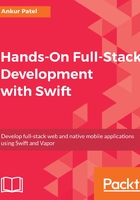
Modern app development
Application development in today's world is not just about building for one platform. Modern applications have an ecosystem of apps that run on multiple devices and platforms. In order for these apps to run on the multiple platforms they also need a server-side component to be able to seamlessly save and retrieve data so that a user can switch between them and start using the app from where they left off on another platform. To make these modern applications possible, developers write code on the different technology stacks that have different programming languages and frameworks/libraries. This makes the job of the developer especially difficult due to the context switching between programming languages when building the application.
In the world of the web, developers have enjoyed working on the frontend web applications using JavaScript but after the introduction of Node.js, web developers who were mainly focused on the frontend could finally work on the backend in a language that feels familiar. Web developers have embraced the idea of working across different technology stacks as part of their app development because they can now write the frontend in JavaScript and use the same language to build server-side components.
Similarly, Swift, which is popular in the world of iOS, tvOS, and macOS for building rich client-facing applications, is now available on server-side thanks to Apple. Like JavaScript developers, Swift developers can now finally build server-side components in a language that is familiar to them while they continue to build frontend applications for different platforms, such as mobile, watch, TV, or desktop. Currently Swift is gaining popularity on the server-side, and it has never been a good time to be Swift developers. We can now engage ourselves in true full stack app development by working on different platforms using the same language and standard libraries that we are familiar with when building iOS, tvOS, watchOS, and macOS applications.